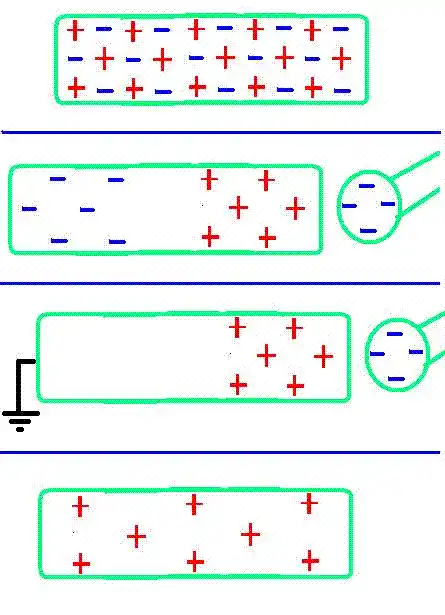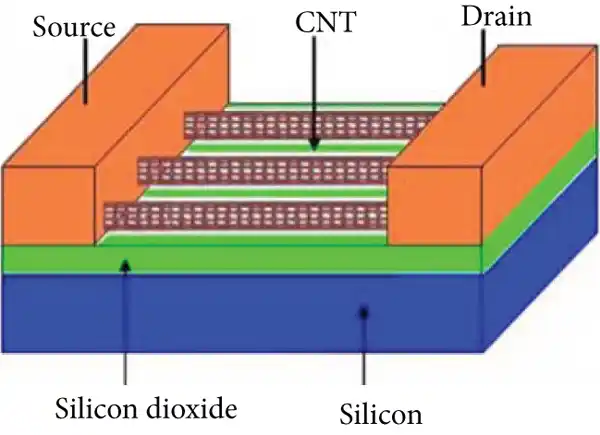Nano Fullerenes with The Ability to Store Electrostatic Energy That can be Used as Nano Supercapacitors With Very High Capacity
Note: Nano fullerenes with the ability to store electrostatic energy that can be used as nano supercapacitors with very high capacity. Also, with these nanotubes, the nervous network can be repaired. Carbon nano fullerenes are allotropes of carbon such as diamond and graphite. These compounds are made of carbon and take on spherical and elliptical shapes. Those that are spherical are called buckyballs.
Fullerenes do not have much chemical activity. The width of the graphite plate is about a few nanometers. The length of the nanotubes ranges from a few micrometers to less than a meter. Their unique molecular structure creates unusual macroscopic properties.
Non-carbon nano fullerenes
In non-carbon fullerenes, other elements create a structure similar to fullerenes, the chemical structure of these fullerenes is often metal oxide, vanadium oxide is one of them.
Intrahedral fullerenes
They enclose different atoms inside themselves, the obtained nanostructures are used for applications such as tracking elements and biological processes.
Multilayer fullerenes
Multilayer fullerenes consist of several fullerenes that are inside each other. For this reason, this structure is also called nano onion.

Fullerenes are sensitive to light and their electrical properties change drastically with the change of wavelength of light. Such as: organic light-emitting diodes with long life and high performance, and fullerene molecules can be filled by other elements. For example, by placing some metal elements inside fullerenes, their electrical properties can be improved. Also, fluorine molecule can be used for storage in nano supercapacitors and confinement of non-carbon atoms .

Conclusion :
Carbon nanotubes are called stretched fullerenes. And graphene sheets are used to empower carbon nanotubes. Nano fullerenes with the ability to store electrostatic energy that can be used as nano supercapacitors with very high capacity.
[1][2][3][4][5][6][7][8][9][10][11][12][13][14][15][16][17][18][19][20][21][22][23][24][25][26][27][28][29][30][31][32][33][34]
References
- ^Lei Choe. (2024). Review of: "The field-effect tunneling transistor nMOS, as an alternative to conventional CMOS by enabling the voltage supply (VDD) with ultra-low power consumption,". Qeios. doi:10.32388/z3oxov.
- ^Afshin Rashid. (2024). Review of: "transistor nMOS (with ultra-low power consumption, energy-efficient computing, during the sub-threshold range)". Qeios. doi:10.32388/1al4jb.
- ^Afshin Rashid. (2023). Review of: "High speed (doping) nMOS graphene transistor in p- and n-doping electronic circuits (positive and negative)". Qeios. doi:10.32388/jreu5m.
- ^Erkan Ozturk. (2023). Review of: "(Nano transistor) Electronic and biological nanotechnology (Structure, internal building)". Qeios. doi:10.32388/bt5z8a.
- ^Linda Brouce. (2023). Review of: "(Field effect nano transistors) Nano transistor electronic quantity". Qeios. doi:10.32388/12sgvj.
- ^Afshin Rashid. (2024). Review of: "Nano supercapacitors (supercapacitors or electrochemical nanocapacitors)". Qeios. doi:10.32388/67gwcf.
- ^Afshin Rashid. (2024). Review of: "FinFET nanotransistor downscaling causes more short channel effects, less gate control, exponential increase in leakage currents, drastic process changes and unmanageable power densities". Qeios. doi:10.32388/hx4oyk.
- ^Chad Allen. (2024). Review of: "FinFET nanotransistor, the reduction of scale causes more short channel effects, less gate control, an exponential increase in leakage currents, severe process changes, and power densities". Qeios. doi:10.32388/h3qk7b.
- ^Afshin Rashid. (2023). Review of: "Nano electrical memories and testing Nickel nanoparticles NI_nanoparticle Strong conductors of electric current". Qeios. doi:10.32388/sbe8l8.
- ^Afshin Rashid. (2023). Review of: "Reproduction (electrical nano memories) by the method combined nanolithography (۱۲ V), Fast switching speed (۱ microsecond)". Qeios. doi:10.32388/jg1x8x.
- ^Afshin Rashid. (2023). Review of: "Experiment (nanoelectronic memory) using small organic molecules Chlorophyll pseudo instead of charge storage capacitors". Qeios. doi:10.32388/k0x2ro.
- ^Marcus Webster. (2024). Review of: "Graphene molecular nanomemories show unique electronic properties, and their small dimensions, structural strength, and high performance make them a charge storage medium for Nano memory applications". Qeios. doi:10.32388/a6k2u7.
- ^Anita Gupta. (2023). Review of: "Amplification of Nano Wires Nano Wire by Electron Nano Lithography". Qeios. doi:10.32388/l3md1n.
- ^Cita O,brain. (2023). Review of: "The changes in the width of the nano transistor channel due to the field effect of the gate around can cause undesirable changes and loss of mobility". Qeios. doi:10.32388/5pfxk9.
- ^Afshin Rashid. (2023). Review of: "(Field effect nano transistors) Nano transistor electronic quantity and ionization potential)". Qeios. doi:10.32388/464lg7.
- ^Afshin Rashid. (2023). Review of: "The concept of (Nano assembler) in smart electronic nano structures". Qeios. doi:10.32388/atyte1.
- ^Afshin Rashid. (2023). Review of: "Oligophenylene vanillin (silicon/germanium ) structured nanowires and cylinders for possible applications in electronic energy". Qeios. doi:10.32388/i5wrmf.
- ^Afshin Rashid. (2023). Review of: "Propagation of Oligophenylene vanillin nanowires by focused ion beam (FIB) nanolithography method (below ۱۰۰ nm - ۱۰ nm range)". Qeios. doi:10.32388/whhfa8.
- ^Afshin Rashid. (2023). Review of: "Nano wire immersion method (structure and function)". Qeios. doi:10.32388/0od0gl.
- ^Carlos Sanchez. (2023). Review of: "Oligophenylene vanillin (silicon/germanium) structure". Qeios. doi:10.32388/59igyk.
- ^Andria Pandich. (2023). Review of: "Nano wire immersion method (structure and performance)". Qeios. doi:10.32388/efe18p.
- ^Andrea County. (2023). Review of: "The concept of (Nano assembler)". Qeios. doi:10.32388/xrrt0e.
- ^Luola Sendros. (2024). Review of: "nMOS instead of exhibiting thermionic emission modulation, changes through a quantum tunnel modulation 12> They change through a dam.". Qeios. doi:10.32388/5sdms6.
- ^Lucas Jeferson. (2024). Review of: "Graphene in nMOS field-effect transistors". Qeios. doi:10.32388/1aozqy.
- ^Afshin Rashid. (2024). Review of: "Many types of electrical nano-sensors using CP nanomaterials designed for nano-biological applications". Qeios. doi:10.32388/lytuvb.
- ^Afshin Rashid. (2024). Review of: "In general, an electrical nano-biosensor consists of an immobilized static biological system ( based on their own built-in immobilized static biological system)". Qeios. doi:10.32388/pq6ho0.
- ^Afshin Rashid. (2024). Review of: "A combination of interference nanolithography and nanoelectronics lithography enables the fabrication and reproduction of high-resolution structures in large areas". Qeios. doi:10.32388/qy3s52.
- ^Prienna Radochevich. (2024). Review of: "Block nanolithography Oriented copolymer is a combination of top-down lithography and the bottom-up self-organization of two polymers to produce high-resolution nanopatterns over large areas". Qeios. doi:10.32388/a0nexa.
- ^Prienna Radochevich. (2024). Review of: "Block nanolithography Oriented copolymer is a combination of top-down lithography and the bottom-up self-organization of two polymers to produce high-resolution nanopatterns over large areas". Qeios. doi:10.32388/a0nexa.
- ^Afshin Rashid. (2024). Review of: "Nano supercapacitor called (electrostatic) -- The total thickness of each < a i=4>electrostatic nanocapacitors only 25 nm". Qeios. doi:10.32388/247k3y.
- ^Afshin Rashid. (2024). Review of: "distribution of nanotubes by NIR-vis-UV absorption spectroscopyresulting in preparation like valence electrons (dopingP)". Qeios. doi:10.32388/jg6x41.
- ^Afshin Rashid. (2024). Review of: "Production of nano supercapacitors using nanoparticles (a piezoelectric and ferroelectric material)". Qeios. doi:10.32388/c2juls.
- ^Afshin Rashid. (2024). Review of: "bipolar transistors (pMOS) have a state voltage connected (Von) around ۲ to ۳ volts". Qeios. doi:10.32388/c8zgvw.
- ^Afshin Rashid. (2024). Review of: "_ Lindemann's change structure section in electrical nanostructures Lindemann change / (change structure) in multilayer nanostructures". Qeios. doi:10.32388/ttqb0i.

